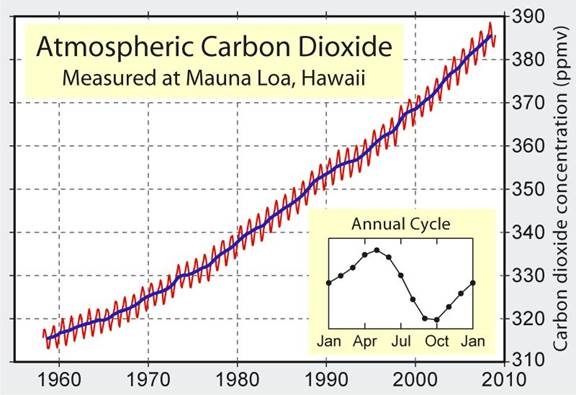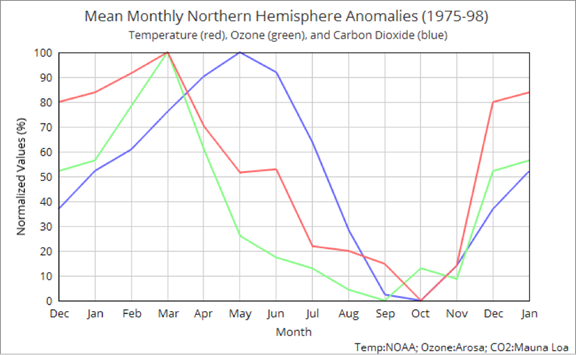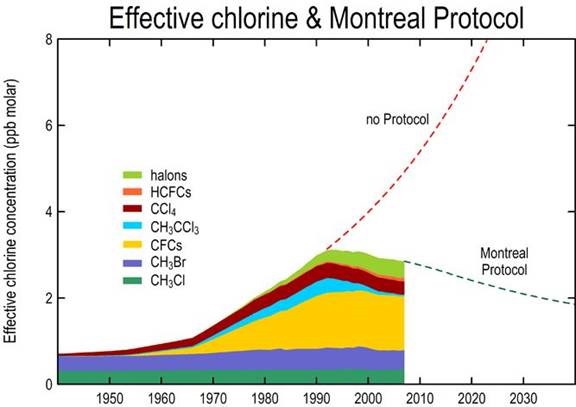Interesting climate sensitivity analysis: Do variations in CO2 actually cause significant global warming?
Guest essay by David Bennett Laing
In 1900, Knut Ångström concluded from a famous experiment that very little warming results from a doubling of atmospheric CO2. Although no similar experiment has been performed since, there is a simple and accurate way to tell by observing hard data from the real world. My approach in this is synthetic and not analytic, and I feel strongly that the integration of a variety of empirical data from the Earth system is essential for a good understanding of how things actually work in Nature.
Here in figure 1 is the Keeling curve, showing the steady increase in CO2 from 1959 to the present, as measured at the observatory on Mauna Loa, Hawaii:
Figure1 – The Keeling curve of atmospheric CO2, Mauna Loa, HI
Notice that there is an annual cycle (small squiggles) superimposed on the general increasing trend. If you average the monthly records for these cycles for each year, you wind up with the curve in the inset, which shows that, on the average, CO2 reaches a maximum concentration in the month of May in the northern hemisphere, when the CO2 from the winter’s decaying vegetation has warmed up and can enter the atmosphere, and a minimum in September-October, when photosynthesis during the summer has used up some of the CO2 in the atmosphere. The difference between the maxima and the minima is about 6 parts per million (ppm).
I have reproduced this inset curve for CO2, peaking in May, in the following graph as figure 2 (blue curve, all values in percent):
Figure 2 Mean monthly value comparison of temperature, ozone, and carbon dioxide from 1975-1998
I took the NOAA record of northern hemisphere temperature anomalies (red curve, above) and gave it the same treatment for the 24-year period 1975 to 1998, when the globe warmed dramatically by nearly one degree centigrade. Notice that the temperature anomaly has its maximum value in March, two months before the maximum of the CO2 curve.
Now,
if variations in the concentration of CO2 in the atmosphere had any effect on temperature, you would expect that the peak in CO2 would occur with or before the peak in temperature, but it actually occurs two months afterward, which shows that variations in atmospheric CO2 cannot possibly have a significant effect on temperature. Notice, however, that there is a very small up-tick in the temperature anomaly in June, showing that in fact CO2 actually does have a slight effect on temperature, but not a significant one.
What does
the green curve represent? I gave the same treatment to
the record of ozone depletion from Arosa Switzerland, for the same 1975 to 1998 period of rapid warming.
Notice that it peaks in March, the same month in which temperature peaks. Both these peaks are sharp, suggesting a strong relationship between the two (the correlation coefficient between the red and green curves is 0.92, i.e., very high).
This means that
there is a strong probability that it is ozone depletion, rather than CO2, that is really responsible for global warming. The interval 1975 to 1998 also happens to be the period during which chlorofluorocarbons (CFCs) were introduced to the atmosphere by spray cans and leaky refrigerators, as is shown by the graph below (effective chlorine means all anthropogenic sources of chorine and bromine):
Figure 3 – Montreal Protocol
As is well known, CFCs break down in March (in the northern hemisphere) on polar stratospheric clouds, and the chlorine and bromine thus released cause ozone depletion, including the ozone hole. The Montreal Protocol took effect in the ’90s and stopped the ongoing destruction of ozone, but because chlorine and bromine destroy ozone catalytically, most of these chemicals are still up in the stratosphere and are still destroying ozone, as the graph above shows. It will therefore take until at least mid-century for temperature to return to normal.
But why should ozone depletion cause global warming? That happens simply because the ozone layer shields Earth from Sun’s ultraviolet-B radiation (UV-B), which is 48 times hotter than Earth’s infrared radiation. When ozone is depleted, more UV-B can penetrate to Earth’s surface. In the late 20th century, however, everyone was concerned about this causing genetic damage and sunburn, but no one thought it could cause global warming as well. Apparently, it can, however, as is shown by the second graph.
All this very nicely explains why temperature rose so fast in the late 20th century, and why it leveled off again in what has been called the “global warming hiatus” (as if Earth were doing something wrong relative to the climate models!), but
why did temperature jump up again in 2015?
This probably happened because
from mid-2014 to early 2015, one of Iceland’s non-explosive volcanoes, Bardarbunga, underwent the largest basaltic eruption since Laki in 1783. The erupted lavas put chlorine and bromine into the atmosphere as hydrogen chloride and hydrogen bromide, which had the same effect on the ozone layer as CFCs from spray cans. They depleted the ozone layer and admitted more solar UV-B. Now that this event is over, things can, and probably will, return to “normal,” i.e., to “hiatus” conditions.
It should be noted here that explosive, andesitic volcanoes are well known to produce global cooling because they put a lot of sulfuric aerosols into the stratosphere, which reflect away sunlight. Together, explosive andesitic and non-explosive basaltic volcanoes have been causing global cooling and warming, respectively, throughout much of geologic history, as a careful review of the geologic record attests.
The bottom line is that the demonization of carbon dioxide is probably a mistake, and is unnecessary, as is the plan to replace all kinds of fossil fuels with less efficient, more expensive, environmentally destructive, non-renewable energy sources at great expense and socioeconomic disruption. The probability is that in going after CO2, we are going after the wrong target, and it will do no good.
It seems far more important to make sure that the Montreal Protocol is assiduously followed, and that CFCs are closely monitored, going forward.
For the record, I am a dedicated progressive and no friend of any of the fossil fuel industries, in which I have no investments whatsoever. I am simply concerned with doing science right and (to borrow a metaphor from Cervantes) with saving us from falling flat on our face by tilting at the wrong windmill.




